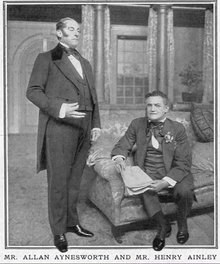
Summary
The Dover Road is a three-act comedy by A. A. Milne, seen on Broadway in 1921–22 and in the West End in 1922–23. It depicts the dampening effect of close proximity on the ardour of eloping couples when they are forced into sustained exposure to each other's habits and idiosyncrasies.


Premieres edit
The first production opened at the Bijou Theatre, New York on 23 December 1921 and ran for 204 performances.[1] The play opened at the Haymarket Theatre, London, on 7 June 1922, and ran for 268 performances, until 13 January 1923.[2]
Original casts edit
| New York | London | |
|---|---|---|
| Dominic, the butler | George Riddell | Allan Aynesworth |
| Mr Latimer | Charles Cherry | Henry Ainley |
| Leonard | Reginald Mason | Nicholas Hannen |
| Anne | Winifred Lenihan | Nancy Atkin |
| Eustasia | Molly Pearson | Athene Seyler |
| Nicholas | Lyonel Watts | John Deverell |
| The staff | Phyllis Carrington Edwin H. Morse George Nolan Ann Winslow |
Donald Ferguson Walter Lake Joyce Kennedy Kitty Strudwick |
Plot edit
The scene is the reception-room of Mr Latimer's house, a little way off the Dover Road.
The rich and eccentric Mr Latimer's idea of philanthropy is to waylay eloping couples en route from London to Paris by way of the Dover Road. With the aid of his magisterial and benign butler he keeps them confined together at his house for a week to discover for themselves whether they are truly compatible when exposed to each other's constant company. Leonard (an English peer) is eloping with Anne, a young woman of very modern views. When they are delayed by a series of accidents, contrived by Latimer, from getting to Dover in time to catch the channel boat, they are brought to his house, which they are told is a hotel. Once there, they are courteously, luxuriously but firmly imprisoned together. They rapidly discover each other's irritating habits. Another eloping couple already in enforced residence in Latimer's house consists of Leonard's wife, Eustasia, and Nicholas, a bored young man. They too have fallen into Latimer's trap, and found the urge to elope wearing off. The two couples meet. Leonard is ill with a cold, and Eustasia nurses him in such a solicitous manner that it drives him to distraction. Anne and Nicholas seem on the verge of a liaison, but that too founders. They go their separate ways. Leonard and Nicholas find each other's company congenial, and they decide to use the tickets booked for their abortive elopements and go en garçon on a jaunt to Cannes together. As the play ends, a new eloping couple ring the bell and Latimer's scheme swings into action once again.[3][4]
Critical reception edit
Reviewing the Broadway production, Percy Hammond wrote in The New York Tribune that the play was "a quietly twinkling, adult entertainment – one that you will enjoy".[5] In The New York Times the following year, Alexander Woolcott ranked the play with The Truth About Blayds as one of Milne's best plays.[6] After the West End premiere, The Stage described the piece as "one of the most notable English comedies of modern times" and asked why Broadway audiences had been allowed to see it first.[3] The Era commented that the play had "a brilliant first act, rich in comedy, a farcical second act, no less laughter compelling, and a third act in which an element of the fantastic enters", and found the piece "another Haymarket triumph".[4]
Adaptations edit
A 1927 silent film The Little Adventuress was made. In 1934 the play was adapted into an American film, Where Sinners Meet, directed by J. Walter Ruben and starring Diana Wynyard and Clive Brook.[7] The film's working title was The Dover Road.[8]
BBC Television adapted the play for their anthology series Saturday Playhouse; broadcasting the work in September 1958 with Clive Brook once again portraying Mr. Lattimer, Gene Anderson as Anne, Eleanor Summerfield as Eustasia, Cyril Raymond as Leonard, and Desmond Davis acting as producer.[9]
References edit
- ^ "The Dover Road", Internet Broadway Database. Retrieved 26 April 2021
- ^ Wearing, p. 172
- ^ a b "London Theatres", The Stage, 15 June 1922, p. 14
- ^ a b "Premieres of the Week", The Era, 14 June 1922, p. 9
- ^ Hammond, Percy. "The New Play", The New York Tribune, 24 December 1921, p. 4
- ^ Woolcott, Alexander in The New York Times, 15 March 1922, quoted in Beckerman and Siegman, p. 28
- ^ Capitol Perth Daily News, 9 February 1935, p.7, at Trove
- ^ "Where Sinners Meet: Detail View". American Film Institute. Retrieved 13 March 2016.
- ^ M. C. (18 September 1958). "Brilliant Production: 'THE DOVER ROAD'". The Stage (4, 310): 7.
Sources edit
- Beckerman, Bernard; Howard Siegman (1973). On Stage: Selected Theater Reviews from The New York Times, 1920–1970. New York: Quadrangle. ISBN 978-0-81-290363-8.
- Wearing, J. P. (2014). The London Stage 1920–1929: A Calendar of Productions, Performers, and Personnel. Lanham, Maryland: Rowman & Littlefield. ISBN 978-0-8108-9302-3.
External links edit
- The Dover Road — in Three Plays (1922) by A. A. Milne at the Internet Archive


